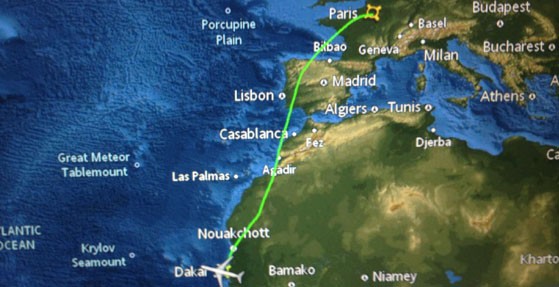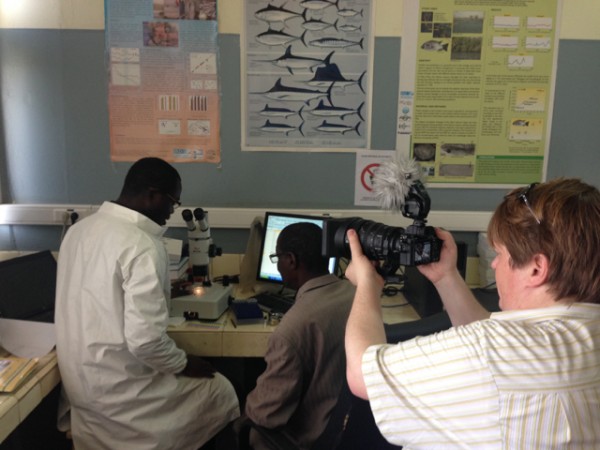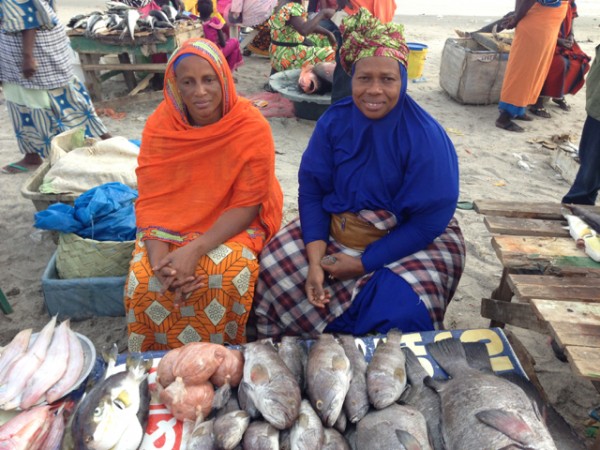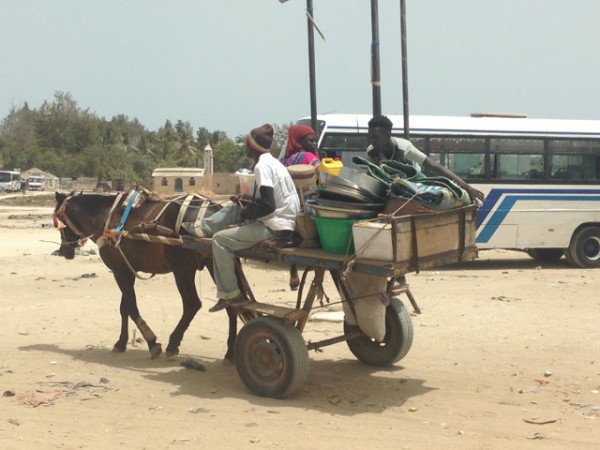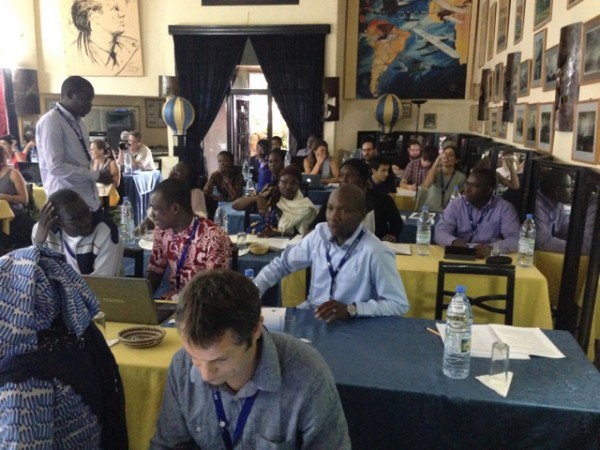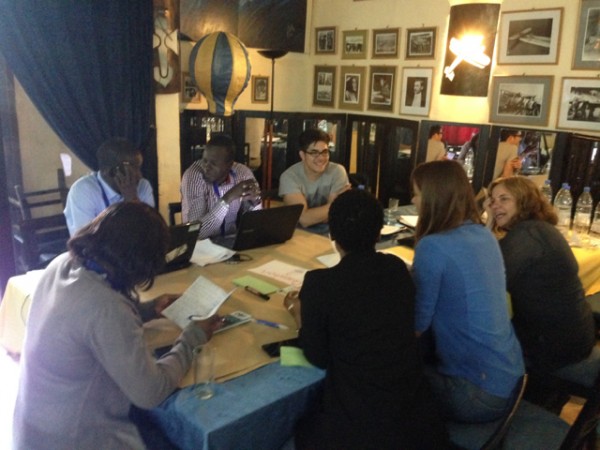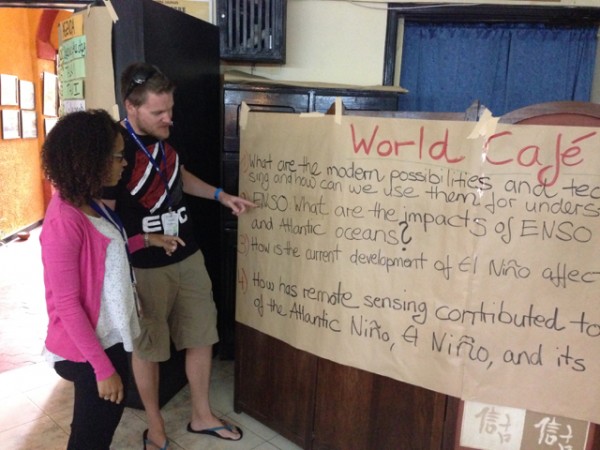Report from the International Summer School "Ecology of Eastern Boundary Upwelling Systems (EEBUS)" in Senegal
![]()
![]()
![]()
![]()
![]()
![]()
![]()
30.4.16
Saint-Louis, Senegal
The morning is taken up by the assembly of the fishermen’s organisation SYNAPS (Syndicat National Autonome des Pêcheurs du Sénégal) to which Dr. Werner Ekau has been invited. The meeting at the local chamber of commerce is attended by officials from the fisheries ministry. Over the next couple of days there will be panel discussions and talks on the impact of the government’s Emerging Senegal Plan on fisheries as well as aquaculture. Dr Ekau explains about our summer school taking place in Saint-Louis and talk about some of the scientific topics that we are discussing.
Back at the summer school the day is dedicated to analysing the reason why there small pelagic fish abundance fluctuates and to compare fishing policies in EBUS and look at small pelagic fish exploitation. After the lecture all participants come together to form a Samoan circle. During this session only the people in the inner circle are allowed to speak. If participants like to contribute to the discussion they need to move to the inner circle and a person from the inner circle needs to make leave the seat. During this next 90 minutes participants identify what is not known about processes in the EBUS and what question should be posed to improve the understanding of EBUS role in climate change, ecosystem functioning and service. The results of this discussion is also used as a basis to think of possible future collaborations and joint funded international projects. The summer school ends in the early evening with a feedback session. The reaction from the group were overall positive, especially with regards to the group work which was generally seen as a great tool to not just get to know one another but also to delve deeper into a subject or to get clarity on what was not understood during the talks. Over the course of the summer school groups were slightly adjusted for each group to include at least one of the experts, which further helped the discussions and the understanding. As English was for not the first language for most participants, the group worked also helped on that level to explain processes to those who had not always understood everything from the lectures. Prof. Papa N’Diaye summed it up nicely: “I think you will continue to reflect on the content and to keep the contacts and friends you have made here in Senegal.”
29.4.16
Saint-Louis, Senegal
Having heard from the local fishermen about their way of managing their fishing efforts and introducing strategies to limit fishing, it is fitting that today’s talks and lecture centre on eco-system based management of EBUS as well as the food web structure and ecosystem production. During the interactive sessions participants are working on a case study of ecosystem-based management with the aim to visualize the management structures and also taking into account the different sectors, disciplines and agencies. The World Café session, meanwhile, investigates the effects of overfishing in the Benguela systems whilst also taking a close look at the difference between the south and west coats of that particular upwelling system.
Later on it’s time for a short cooking lesson. Having bought some dried bissap (tropical hibiscus) leafs on the market I now need to know how to use them to make the tasty juice that I have been drinking almost every day. The hotel’s manageress is kind enough to teach me so I can try to make bissap back at home.
28.4.16
Saint-Louis, Senegal
After a morning of talks and group work focusing on the role of EBUS as CO2 sources and sinks, the afternoon is spent in town. We are visiting a fish processing plant near the beach in Guet N’Dar on the island Langue de Barbarie. Not as large as the one we saw in Dakar, it nonetheless processes 8,000 tons of fish every year. Here, the women use three different techniques to process the fish: fermented and sundried, salted and sundried as well as smoked and sundried. The dried fish is then mainly taken inland to regions that cannot get any of the fresh fish because they are too far away. For the Senegalese living in these areas the fish is an important source of protein. 75,000 tons of fish are landed in Guet N’Dar each year. From June to October fish stocks are low, whilst from October to June they are much higher, which of course influences the price.
We also meet some local fishermen who tell us that they have noticed that the fish stock has gone down in recent year and there is less fish for them to catch. They put the problem down to overfishing – as with more than 3000 boats heading out to sea the fishing effort is high. To counteract this they have put some management procedure in place: Half of the boats go out one day then they stay on land they next. But even if the fishing per pirogue is decreased the problem remains for the number of boats is constantly increasing. Regulation is generally a bottom-up process, the fishermen, who have set up an organization to represent their interests, propose a management idea and in turn the administration puts it into regulation. At the end Dr. Werner Ekau is invited to join one of the organization’s official meeting which takes place in a couple of days.
27.4.16
Saint-Louis, Senegal
Today is all about the “Physics of the Ocean and of the Atmosphere”. The goal of the day is to understand and acknowledge the advances in modeling and remote sensing techniques, which have contributed a lot to the understanding of the spatial and temporal variability in the EBUS.
After the morning talks everyone gets together for the “World Café”. Participants split up into six groups to work on one of four questions related to the topics of the day and come up with a poster at the end of their group work. The different groups present their posters, before breaking up for a bite to eat. The afternoon’s focus is on teleconnections (long-distance relationships) between atmospheric and oceanic patterns, followed by the seasonal regulation of primary production in the EBUS.
A brainstorming session follows during which everyone assembles at one side of the room in front of a large world map. The task is to identify teleconnections between the upwelling systems and the workshop proves to be a great forum for vividly pooling knowledge and ideas. While some people ask for clarification of subjects, others provide new information or explain particular causes and effects that the different long-distance atmospheric and oceanic patterns have on the upwelling systems. In the end the world map is full of circles, lines and arrows illustrating a great number of teleconnections. Scientific exchange is alive and kicking, brains are buzzing and some of the discussions will most certainly resume over dinner.
26.4.16
Saint-Louis, Senegal
It’s the first day of the summer school. The objective of the day is to identify main similarities and differences between the four main EBUS. We have four speakers giving an overview of each upwelling system – the Canary, the California, the Humboldt, and the Benguela. After each talk, participants and speakers form groups to identify things they didn’t understand, questions they might have or knowledge they might like to add. At the end of a busy, but inspiring day some of the main topics and questions that have arisen from the group work are summarised by Dr. Werner Ekau from ZMT for further discussion the next day.
25.4.16
Saint-Louis, Senegal
Ana and Kristin from ZMT are putting the finishing touches to the conference room at the Hotel de la Poste in Saint-Louis. One of the hotel’s most famous residents was French author Antoine de Saint-Exupéry who stayed here during his time as an Aeropostale pilot working the mail service from Toulouse to Dakar in the 1920s.
Meanwhile, over in Dakar, the speakers and participants of the EBUS summer school have arrived from different corners of the world. A bus is taking the 50-strong group to Saint-Louis. They arrive in the afternoon. After freshening up, Professor N’Diaye is taking some of the group for a walk through town to see the Guet N’Dar. In the evening we all come together for an “icebreaker” to get to know each other. Everyone asked to summarize what they are expecting from the talks, discussions and group work starting the next day. “Learning, learning and learning,” says one participant from Morocco. “Good brainfood,“ adds another from Germany. Plenty of both will most certainly be served up over the coming days.
24.4.16
Dakar – Saint-Louis, Senegal
Yesterday was spent mainly on the road driving to our conference of Saint-Louis. At the side of the road we saw women and men selling melons, mango, mandarins and other local fruit. We drove past mango trees and the famous baobab. Still, once in Saint-Louis we appreciate not to see life pass us by through a car window and to able to go for a bit of a walk around town with Seynabu, who has now become our official film location manager.
The old town of Saint-Louis is located on an island at the mouth of the Senegal river. You can reach it from the mainland via the impressive Pont Faidherbe bridge. The town also extends to the neighbouring island of Langue de Barbarie. Saint-Louis was the first French settlement in West Africa in the 17th century. As the Senegalese capital from 1872 to 1957 it had a significant cultural and economic role in the all of West Africa. In 2000 the town became a UNESCO World Heritage Site.
We are hoping to film fish landing again so we head out to the quarter of Guet N’Dar where around 14,000 fishermen work. This time we have to go by car again as we need to take the filming equipment. Right at the end of the beach we finally find a pirogue that has landed. The men are unloading their catch and a number of women are buying up a small share of the fish. The rest is loaded into a truck to be driving away for processing or to other markets inland. Seynabu talks to the men and women in the local language of Wolof and after a while they are happy for us to film them at work.
22.4.16
Dakar, Senegal
We are visiting our host Professor Papa N’Diaye at his office and laboratory at the IFAN (UCAD), where we also meet his colleague Didier Jouffre from the Institut de Recherche pour le Dévelopment (IRD) in France and Luc Badji, a PhD student at UCAD. They will both be joining us in a few days at the summer school in Saint Louis. We are filming the two researchers and are watching the scientists working in the lab.
In the afternoon, we are joined by Seynabu Camara, a fisheries officer from Dakar and master student at UCAD. Over the course of the week she will accompany us to our different locations and explain to the locals who we are and what our film is going to be about. The four of us are now heading to the fish processing in Thiaroye-sur-mer, a suburb of Dakar. Fishery and fish processing is one of the main economic drivers and export industries in Senegal alongside mining, construction, tourism, and agriculture. The nation is one of the countries benefitting from the fish abundance in the Canary Current System, which runs from Northern Spain to Southern Senegal. But climate change and overfishing from large industrial fleets has had detrimental effects on the fish populations affecting the fishermen directly.
At Thiaroye-sur-mer we are already expected by around 30 of the more than 200 women working at the plant. They are sitting on the floor surrounded by huge tables of different species of fish drying in the sun. The smell is overwhelming at first, but after a while we don’t notice it anymore.
At the plant all pelagic fish are processed depending on what the fishermen bring in with the catch. Contrary to our first belief, the women are not employed by the processing plant. Each woman works for herself. They buy the fish at the market, process it, and sell it on to the plant, which then exports it to neighbouring African countries such as Mali, Burkina Faso, Togo, Ivory Coast, or Congo. If a big advance order comes in, however, they all join forces to get the job done and split the profits.
Up to 20 tons of fish are processed here every month, the method used is a mixture of fermentation in water and drying in the sun. Fish processing is a job traditionally done by women in Senegal, while the men go out to sea. The fish processing at Thiaroye-sur-mer is a project, which is supported by the Senegalese government to keep women in their jobs. The money these women earn goes to the family and the children. At the plant the women work an average of 12 hours a day, the oldest woman is 95 years old, most have started at the plant in their teens. The fishermen, meanwhile, start their work around 20 years of age, they are only physically able to work this job up to their mid-40s after which they traditionally pass the boats – the pirogues – on to their sons and the women become the sole earners for the family. As a rule and a sign of solidarity the young fishermen always give a part of the catch to the retired.
In the early evening at around 6 pm the fish landing begins, so we are leaving the plant to drive to one of the fish markets of Dakar. Traffic is getting very busy and stops at times. Young boys are hoping to sell peanuts, cashews, fruit, CDs, pots and pans, and sunglasses to the drivers stuck in the queues. We get some biscuits made from the fruits of the baobab tree – the national symbol of Senegal; they taste a bit like dried mango, sweet and a bit citric. You cannot be in Senegal without listening to some of its famous music. Our driver Habibub sticks on some Wally Seck and Pape Diouf, as we already know the singer Youssou N’Dour. The upbeat sounds help to pass the time being stuck in traffic.
Eventually we arrive at the beach and the fish market. The market officers tell us that there won’t be any fish brought to shore today. The wind was too strong for the fishermen to go out. There are still some fish being sold possibly from yesterday’s catch. We follow our guides walking between the men and women offering their wares. We postpone filming the fish landing until we get to Saint-Louis and make our way back to the car to return to the hotel. It will be an early start again for us, as we will be visiting Lac Rose, a salt lake turned a pink hue to the Dunaliella salina algae growing in the lake. As we are planning a stop-over there on the last day of the summer school, we need to make last preparations. We are also due to pick up another colleague from Dakar airport to then start the five-hour drive to Saint-Louis. Although only 200 km away the roads won’t allow fast travel, which makes the trip quite a long one.
21.4.16
Dakar, Senegal
We headed out early to Senegal to help our colleagues with all the preparations for the summer school and do a recce for our filming project. Joined by Matthias, a local filmmaker from Bremen, we flew out to Dakar via Paris with five pieces of luggage in tow, most of it filming equipment. After a journey of almost twelve hours, we finally arrived at Dakar airport at around ten o’clock at night. Passport control is tight with finger scanning and detailed questioning about where we’d be staying in Dakar. None of the luggage had been lost, so the next challenge was to get the required stamps for the filming equipment.
But finding the customs officer responsible turned out to be relatively easy, as we were led by airport officials to an office outside of the terminal. Met by a large crowd of cabbies on route offering their services, we were happy to have already found the person who was picking us up. Driving through Dakar at night, we tried to take in the city and get a sense of the place that was going to be our home for the next week. We got to our hotel at around midnight. Dakar time is two hours behind so we decided to retire after a quick beverage as it was already 2 am for us.
The next day’s schedule was packed with filming appointments kindly arranged by our host Professor Papa N’Diaye from the Laboratoire de Biologie et d’Écologie des Poissons (LABEP-AO) of the Institut Fondamental de l’Afrique Noir (IFAN) at the Université Cheikh Anta Diop de Dakar (UCAD) . The institute is the main partner in the EEBUS summer school, which the ZMT was able to organize with financial support from the VolkswagenStiftung . The overall topic of the summer school is the four upwelling areas in the world.
The Canary Current System, the Benguela, the Humboldt and the California Current System account for 30% of the fish catch worldwide, which amounts to roughly 30 million tons per year. The aim of the summer school is to look for common features and processes in the four upwelling areas and to foster the understanding of the different systems. So from April 25, 16 lecturers and more than 30 PhD students and post-docs from 14 different countries in Africa, Europe and the Americas are gathering in the city of Saint-Louis, about 200km from Dakar.
Andrea Daschner, Science Management





